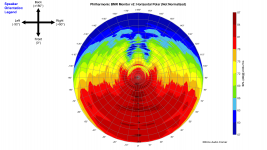https://www.erinsaudiocorner.com/loudspeakers/linkwitz_lx_mini/
No set of measurements completely describe how a speaker sounds - it’s a visual translation of an auditory event- but Erin does it better than anyone else who is publishing measurements.
exhibit A:

@bikinpunk Thank you Erin, for listening work and descriptive comments before your measurements. Your methodology, experience and interpretation is advancing our understanding.
For dipoles, I must say the CTA2034A isn’t all that helpful- I went straight to the Youtube review to hear what you had to say about this speaker.
No set of measurements completely describe how a speaker sounds - it’s a visual translation of an auditory event- but Erin does it better than anyone else who is publishing measurements.
exhibit A:
@bikinpunk Thank you Erin, for listening work and descriptive comments before your measurements. Your methodology, experience and interpretation is advancing our understanding.
For dipoles, I must say the CTA2034A isn’t all that helpful- I went straight to the Youtube review to hear what you had to say about this speaker.
Attachments
Last edited:
Also Amir of ASR has been sent a LXmini, but with Dave Reite's dsp settings. As far as I've read, SL's xo is LR2 and Dave's LR4, also with different PEQ settings. LR2 gives a bit wider range of cardioid pattern, which might be audible. On the other hand LR4 might give lower distortion in xo range? I'm a dipole junkie myself and about 10 years ago run sweeps of 4" mid as dipole myself. Backside radiation is far from dipole above 4kHz always with these, because the motor structure is making diffractions. The tube behind the driver is not helping much, as can be seen in spinorama. Vertical dispersion is unique and sadly with very uneven spectrum.
But the basic idea of LXmini is to be minimalistic solution with minimal effort, people should remember that and not expect miracles! As well we must remember that LX521 is the masterpiece of Linkwitz and is totally different construction.
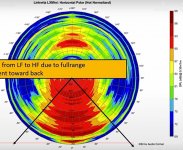
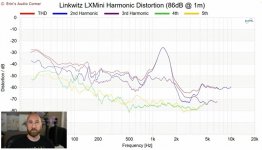
But the basic idea of LXmini is to be minimalistic solution with minimal effort, people should remember that and not expect miracles! As well we must remember that LX521 is the masterpiece of Linkwitz and is totally different construction.


i have 4 pairs of speakers around.
econowave, dynaudio, 3-way horn speakers (cornscala) and the lxmini. apart from a bit harshness in the high-end i always feel like the lxmini are by far the least colored of the speakers. they sometimes dissapear and the others do not at all.
cant explain it based on erins data though.
econowave, dynaudio, 3-way horn speakers (cornscala) and the lxmini. apart from a bit harshness in the high-end i always feel like the lxmini are by far the least colored of the speakers. they sometimes dissapear and the others do not at all.
cant explain it based on erins data though.
For dipoles, I must say the CTA2034A isn’t all that helpful- I went straight to the Youtube review to hear what you had to say about this speaker.

Also,
-don't like that sort of display for polar's either - on general inspection it looks like it's a very narrow beam-width all the way down to 200 Hz (..if you look at it a lot closer then you realize it isn't, but it requires some mental "prep." to actually read it properly - and that sort of defeats the point of a good graphical display).
The standard frontal contour polar map (with gradients) is a lot easier to read IMO:
https://www.princeton.edu/3D3A/Directivity/GedLee Nathan/images/Plots/Horizontal/GedLee Nathan H Front Contour Plot.png
..and if you want to go radial then this *frontal polar (without gradients) is also easy to read and can be useful:
https://www.princeton.edu/3D3A/Directivity/GedLee Nathan/images/Plots/Horizontal/GedLee Nathan H Polar Plot.png
*and of course if you need to show some sort of rear radiation (as with dipole/cardiod/supercardioid/hypercardioid) then it doesn't have to be just frontal.
Also,
-don't like that sort of display for polar's either - on general inspection it looks like it's a very narrow beam-width all the way down to 200 Hz (..if you look at it a lot closer then you realize it isn't, but it requires some mental "prep." to actually read it properly - and that sort of defeats the point of a good graphical display).
The standard frontal contour polar map (with gradients) is a lot easier to read IMO:
https://www.princeton.edu/3D3A/Directivity/GedLee Nathan/images/Plots/Horizontal/GedLee Nathan H Front Contour Plot.png
..and if you want to go radial then this frontal polar (without gradients) is also easy to read and can be useful:
https://www.princeton.edu/3D3A/Directivity/GedLee Nathan/images/Plots/Horizontal/GedLee Nathan H Polar Plot.png
Well, you’re the first one I’ve heard say that in 2+ years. All the feedback has been positive aside from you. Even Bohdan used the idea for SoundEasy. We had an email exchange about it.
Regardless, if you had followed the link for the review you’d have seen the normalized contour you’re talking about is also provided. 😉
I watched the *video (at about 2am last night). 😉 (..and like it!) 🙂
BTW, do you see what I'm referring to - what it looks like lower in freq.?
*note: as a viewer, if I'm spending my time watching your video its very unlikely that I'm going to spend more time going to your link - most of the time I just move-onto the next youtuber site in audio that I'm interested in checking on (..which is usually Joseph Crowe's youtube pages). It's also not that I can't read/understand that particular polar graph, but again - that it requires some unnecessarily added mental processing (enough that I had to pause the video - which is not something that would have happened with either of the above graphs, though the one in your video does provide full polar which is very useful for this particular speaker).
- most of the time I just move-onto the next youtuber site in audio that I'm interested in checking on (..which is usually Joseph Crowe's youtube pages). It's also not that I can't read/understand that particular polar graph, but again - that it requires some unnecessarily added mental processing (enough that I had to pause the video - which is not something that would have happened with either of the above graphs, though the one in your video does provide full polar which is very useful for this particular speaker).
BTW, do you see what I'm referring to - what it looks like lower in freq.?
*note: as a viewer, if I'm spending my time watching your video its very unlikely that I'm going to spend more time going to your link
 - most of the time I just move-onto the next youtuber site in audio that I'm interested in checking on (..which is usually Joseph Crowe's youtube pages). It's also not that I can't read/understand that particular polar graph, but again - that it requires some unnecessarily added mental processing (enough that I had to pause the video - which is not something that would have happened with either of the above graphs, though the one in your video does provide full polar which is very useful for this particular speaker).
- most of the time I just move-onto the next youtuber site in audio that I'm interested in checking on (..which is usually Joseph Crowe's youtube pages). It's also not that I can't read/understand that particular polar graph, but again - that it requires some unnecessarily added mental processing (enough that I had to pause the video - which is not something that would have happened with either of the above graphs, though the one in your video does provide full polar which is very useful for this particular speaker).
Last edited:
I dunno Scott, I think the polars are very intuitive. Perhaps it takes a bit of time getting used to, but it provides far more information at a long pixel stare, as well as a quick glance- I mean, just look at the red!- it's shooting forwards and backwards.
Compare that to Exhibit B (which I put as an attachment). It's another speaker with DIY designer origins, but as well engineered (or better) than many commercial manufacturers IMHO). Again, glance at all the red; that is clearly monopolar - frontal output, but wide dispersion out to nearly 90 degrees.
I'm almost ALWAYS give the Youtube video a miss, I like staring at the data in all it's full uncompressed pixel glory. 🤣
But that's the thing, different strokes for different folks, and Erin's providing more data (objective and subjective) than anyone else.
PS:
Erin, If you haven't already seen this,
https://www.diyaudio.com/community/threads/a-3-way-design-study.376620/post-7013432
2nd image down:
Abrupt non-linear distortion of all harmonics at a single frequency, elevated when driven at higher levels, may be due to a resonance somewhere eg. baffle mounting. If you ever have a chance, try with rubber washers between screws and frame and/or frame and baffle and it may go away.
Compare that to Exhibit B (which I put as an attachment). It's another speaker with DIY designer origins, but as well engineered (or better) than many commercial manufacturers IMHO). Again, glance at all the red; that is clearly monopolar - frontal output, but wide dispersion out to nearly 90 degrees.
I'm almost ALWAYS give the Youtube video a miss, I like staring at the data in all it's full uncompressed pixel glory. 🤣
But that's the thing, different strokes for different folks, and Erin's providing more data (objective and subjective) than anyone else.
PS:
Erin, If you haven't already seen this,
https://www.diyaudio.com/community/threads/a-3-way-design-study.376620/post-7013432
2nd image down:
Abrupt non-linear distortion of all harmonics at a single frequency, elevated when driven at higher levels, may be due to a resonance somewhere eg. baffle mounting. If you ever have a chance, try with rubber washers between screws and frame and/or frame and baffle and it may go away.
Last edited:
Full horizontal polar and gradient - definitely more information. 👍 The only graph having even more is a balloon (which includes all of that horizontally and vertically).
Mentally adjusting for both the freq. response "rings" and the shrinking angle (as any given angle becomes more narrow toward the center) is a bit much. You can "vector-in" on any given angle and freq. and get the information you need (and it does have a lot of information), but looking at it as a "whole" not only does not give you a good idea of what the horizontal directivity pattern is, but actually provides you with an erroneous view of the loudspeaker's directivity. The LXmini's radial plot at a glance of the whole (horizontal pattern) looks like it is fairly uniform in directivity from 200 Hz up excepting about 4 kHz & 11 kHz up in the frontal lobe.

Of course - it's not a fairly uniform horizontal pattern from 200 Hz up and 4kHz isn't really a problem.
While it's a bit "wonky" to see the rear lobe in this graph (again, useful data - but you need to mentally process that the top and bottom of the graph is the rear horizontal output, which is a LOT easier IMO than the gradient radial), I can actually tell what the frontal directivity pattern is horizontally with just one glance (though IMO I'd prefer it non-normalized):

..but of course Erin provides this information on his website - so it's not really a problem so long as any given viewer has a pretty good understanding of what is being displayed in the video and is willing to go to the website for more information. That's a big caveat though for inexperienced viewers.
Mentally adjusting for both the freq. response "rings" and the shrinking angle (as any given angle becomes more narrow toward the center) is a bit much. You can "vector-in" on any given angle and freq. and get the information you need (and it does have a lot of information), but looking at it as a "whole" not only does not give you a good idea of what the horizontal directivity pattern is, but actually provides you with an erroneous view of the loudspeaker's directivity. The LXmini's radial plot at a glance of the whole (horizontal pattern) looks like it is fairly uniform in directivity from 200 Hz up excepting about 4 kHz & 11 kHz up in the frontal lobe.
Of course - it's not a fairly uniform horizontal pattern from 200 Hz up and 4kHz isn't really a problem.
While it's a bit "wonky" to see the rear lobe in this graph (again, useful data - but you need to mentally process that the top and bottom of the graph is the rear horizontal output, which is a LOT easier IMO than the gradient radial), I can actually tell what the frontal directivity pattern is horizontally with just one glance (though IMO I'd prefer it non-normalized):
..but of course Erin provides this information on his website - so it's not really a problem so long as any given viewer has a pretty good understanding of what is being displayed in the video and is willing to go to the website for more information. That's a big caveat though for inexperienced viewers.

Last edited:
Balloon graphs are very demostrative about the basic difference of LXmini vs. boxed small 2-way. Forget the on-axis wiggles and look at what happens wider than 60deg off-axis! That sound is not counted for preference or reflected spectrum DI. Room response and late decayed energy of these will be very different, and that is what makes dipoles and omni/dipole like LXmini to "disappear" and to give sound that fills the room.
What I really would like to see, is LX521 polars!
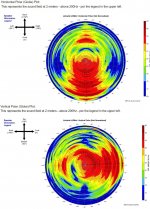
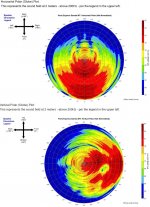
What I really would like to see, is LX521 polars!


Last edited:
What I really would like to see, is LX521 polars!
You and me, both.
PS:
Erin, If you haven't already seen this,
Someone replied to my YT video and said that the single driver itself (the 4" Seas) is the culprit and provided a link to the data showing it. I looked at the mfg impedance data and you see a wiggle at that frequency. So, apparently it's the Seas driver itself; not the enclosure/speaker design.
Yes there’s a dip in the FR and corresponding blip in the impedance response, as well as a rise in H2, that is known.
I’m a little surprised H3/H4/H5 rockets up at a higher drive level. If this is all due to cone edge resonance, then I was not aware.
Juha, you could probably transform your avatar into a polar and its wouldn't be far off most dipoles like the lx521. 😉
I’m a little surprised H3/H4/H5 rockets up at a higher drive level. If this is all due to cone edge resonance, then I was not aware.
Juha, you could probably transform your avatar into a polar and its wouldn't be far off most dipoles like the lx521. 😉
FWIW, if anyone in the north Alabama area happens to have the LX521 speakers, I'd love to have a chance to review them.
I may ask Madisound if they can help me out but I really don't wanna push that. I asked if they could help me with pricing on the LXmini and they just took care of it. I don't mind paying for stuff but the LX521 is much more expensive and even if they did help me out with pricing I think it would be far beyond what I can afford to buy just to test and then have to sit on them for some extended period of time while I look for a buyer.
I may ask Madisound if they can help me out but I really don't wanna push that. I asked if they could help me with pricing on the LXmini and they just took care of it. I don't mind paying for stuff but the LX521 is much more expensive and even if they did help me out with pricing I think it would be far beyond what I can afford to buy just to test and then have to sit on them for some extended period of time while I look for a buyer.
Why the hell did somebody send an LXmini to ASR with the non-official (ie, mine) settings?? Is this some sort of clown show???Also Amir of ASR has been sent a LXmini, but with Dave Reite's dsp settings. As far as I've read, SL's xo is LR2 and Dave's LR4, also with different PEQ settings. LR2 gives a bit wider range of cardioid pattern, which might be audible. On the other hand LR4 might give lower distortion in xo range? I'm a dipole junkie myself and about 10 years ago run sweeps of 4" mid as dipole myself. Backside radiation is far from dipole above 4kHz always with these, because the motor structure is making diffractions. The tube behind the driver is not helping much, as can be seen in spinorama. Vertical dispersion is unique and sadly with very uneven spectrum.
But the basic idea of LXmini is to be minimalistic solution with minimal effort, people should remember that and not expect miracles! As well we must remember that LX521 is the masterpiece of Linkwitz and is totally different construction.
View attachment 1077764 View attachment 1077765
I don't believe Amir has the chops to understand, let alone, test this speaker properly. But if he's going to attempt it, it should be in the "official" configuration as defined by SL.
My goodness.
Dave.
FWIW, if anyone in the north Alabama area happens to have the LX521 speakers, I'd love to have a chance to review them.
I may ask Madisound if they can help me out but I really don't wanna push that. I asked if they could help me with pricing on the LXmini and they just took care of it. I don't mind paying for stuff but the LX521 is much more expensive and even if they did help me out with pricing I think it would be far beyond what I can afford to buy just to test and then have to sit on them for some extended period of time while I look for a buyer.
Just to be clear, since I can't edit my post...
I'm near Huntsville, Alabama. I don't mind driving a few hours to meet or to pick these up from someone at their home if someone has a pair they'd be willing to loan me for a few weeks so I can properly audition them and then measure them. I wouldn't expect someone to ship these for review and I know if I owned a pair I would much rather hand them off in person than ship them.
It's a big ask. But who knows... maybe there's someone nearby who would be willing. 🙂
IF you are able/interested, feel free to PM me or email me at hardisj@gmail.com
Thanks,
Erin
<snip>
Dave, if you'd like to email me your settings, I can try to apply those to the test samples I built and we can compare/contrast the original settings directly. My email is one post up.
Erin,Dave, if you'd like to email me your settings, I can try to apply those to the test samples I built and we can compare/contrast the original settings directly. My email is one post up.
I think the situation is highly confusing already, for folks not familiar.
At this point, I feel the speaker system should be measured in ONLY the stock/baseline configuration as defined by Siegfried.
If you're interested in alternate schemes, we've had a venue for that for many years now on the OPLUG. I invite you to join and I can talk turkey with you at length.
Dave.
- Home
- Loudspeakers
- Multi-Way
- LXmini measurements Klippel NFS
